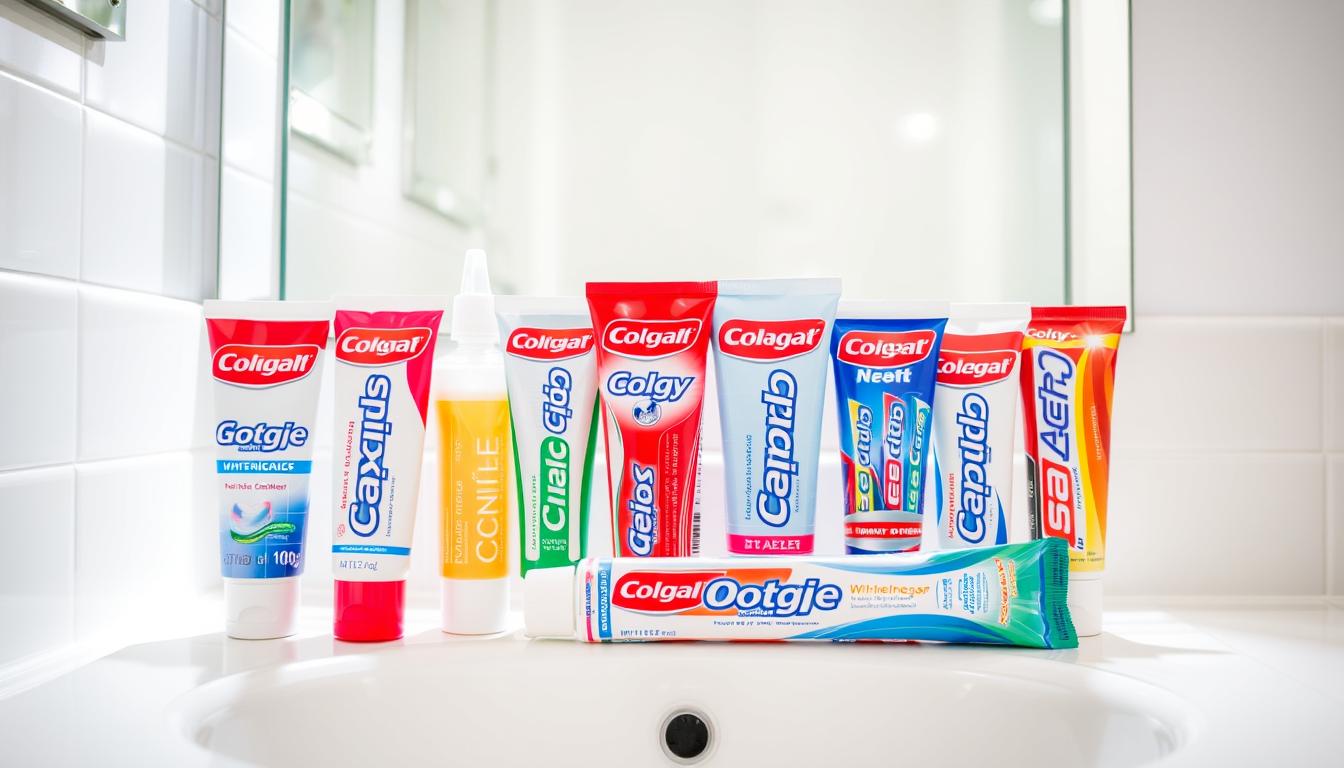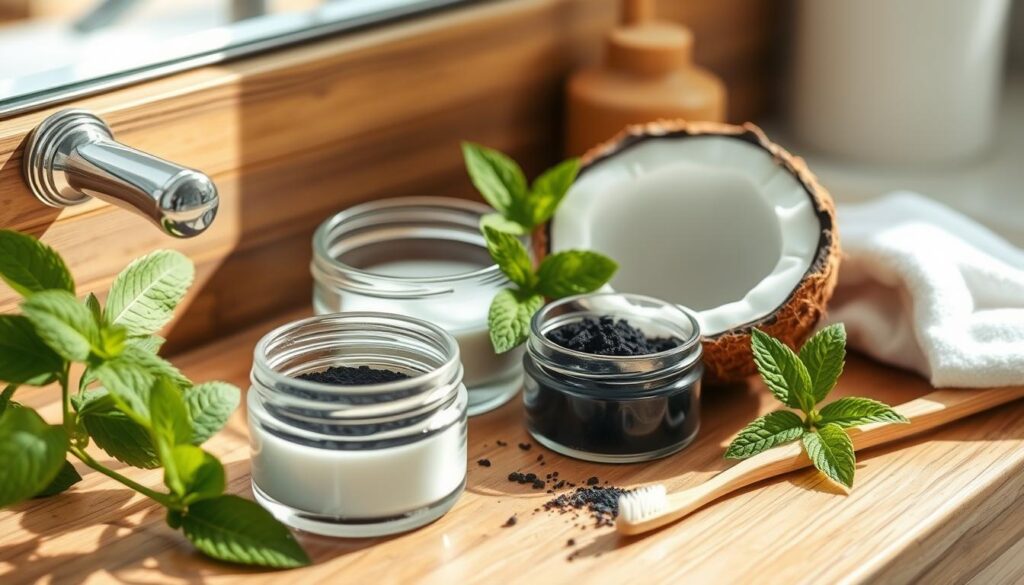October 23, 2024 lori
Are whitening toothpastes safe?

Many people use whitening toothpastes to get a brighter smile. But, are they safe? This article will look into the risks and things to think about when using these products.
Key Takeaways
- Whitening toothpastes can potentially cause tooth sensitivity and enamel erosion.
- Ingredients like hydrogen peroxide and abrasives may be too harsh, leading to long-term dental issues.
- Relative dentin abrasion (RDA) values above 130 can be damaging to tooth enamel.
- Safe alternatives and professional whitening treatments may be a better option for achieving a brighter smile.
- Maintaining good oral hygiene habits and being mindful of dietary choices are crucial for maintaining a healthy, radiant smile.
Whitening Toothpastes: An Overview
Whitening toothpastes are popular for a brighter smile. They mix ingredients to tackle different whitening needs. Knowing how they work helps pick the best toothpaste.
Understanding the Ingredients
These toothpastes use mild abrasives like silica to remove stains. They also have chemical agents like hydrogen peroxide to whiten from the inside.
How They Work to Whiten Teeth
Whitening toothpastes work in two ways: surface and deeper whitening. Surface whitening removes stains on the tooth’s surface. Deeper whitening tackles stains inside the tooth. Choose based on your dental needs and whitening goals.
| Whitening Mechanism | Description |
|---|---|
| Surface Whitening | Removes stains on the tooth’s surface with mild abrasives. |
| Deeper Whitening | Targets stains inside the tooth with chemical agents like peroxides. |
Knowing the whitening toothpaste ingredients and how they work helps choose the right one. This ensures your oral health and cosmetic goals are met.
The Potential Risks of Whitening Toothpastes
Whitening toothpastes promise a brighter smile but can also harm your teeth and gums. It’s key to know these risks before using them.
These toothpastes often have abrasive ingredients like silica or baking soda. These can wear down your tooth enamel over time. This can make your teeth more sensitive and painful.
Whitening toothpastes can also irritate your gums. The harsh chemicals and abrasives can cause inflammation. This leads to redness, swelling, and sometimes bleeding.
| Potential Risk | Description |
|---|---|
| Tooth Enamel Damage | Whitening toothpastes can contain abrasive ingredients that can gradually wear down the protective enamel layer of your teeth. |
| Gum Irritation | The harsh chemicals and abrasives in whitening toothpastes can cause gums to become inflamed, leading to redness, swelling, and even bleeding. |
| Increased Sensitivity | Damage to tooth enamel can make your teeth more sensitive, leading to discomfort and pain. |
The severity of these risks depends on how often you use the toothpaste and your dental health. If problems persist, see a dentist for advice on safe whitening options.
Knowing the risks of whitening toothpastes helps you make better choices. It ensures your teeth and gums stay healthy in the long run.
Sensitivity and Tooth Enamel Erosion
Whitening toothpastes can cause tooth sensitivity and enamel erosion. These issues can ruin the whitening effect and harm your teeth in the long run.
Causes of Sensitivity
Tooth sensitivity is a common side effect of whitening toothpastes. It happens when the dentin layer of the tooth is exposed. This can be due to the abrasive ingredients in these toothpastes, which wear down the enamel.
The chemicals used to whiten teeth can also irritate the nerves in the dentin. This leads to discomfort and sensitivity.
Protecting Your Enamel
Keeping your tooth enamel strong is key. It protects your teeth from decay and other problems. Whitening toothpastes that are too harsh can wear away the enamel, making your teeth sensitive and more prone to cavities.
To keep your enamel safe, choose toothpastes with a low relative dentin abrasivity (RDA) value, below 130.
Also, use whitening toothpaste less often and switch to a non-whitening one sometimes. This can help prevent enamel erosion and tooth sensitivity. By doing this, you can still whiten your teeth without harming them.
Whitening Toothpastes too abrasive relative dentin abrasion over 130
Whitening toothpastes need to be effective yet safe. Many are too harsh, with a relative dentin abrasion (RDA) over 130. This can damage tooth enamel, leading to long-term dental issues.
The tooth enamel protects the dentin beneath. Harsh whitening toothpastes can wear it down. This leaves the dentin exposed, causing sensitivity, pain, and a higher risk of cavities.
The RDA level shows how abrasive a toothpaste is. A high RDA means it’s too aggressive. Whitening toothpastes should aim for an RDA below 250, ideally between 70 and 150.
- Relative dentin abrasion (RDA) over 130 is considered too high for whitening toothpastes.
- Excessive abrasiveness can lead to tooth enamel damage and increased tooth sensitivity.
- Look for whitening toothpastes with an RDA between 70 and 150 for the best balance of safety and effectiveness.
When picking a whitening toothpaste, read the labels carefully. Choose one that balances whitening and enamel protection. This way, you can have a brighter smile without harming your teeth.

“Choosing the right whitening toothpaste is a delicate balance between achieving a brighter smile and preserving the integrity of your tooth enamel.”
Choosing the Right Whitening Toothpaste
Finding the right whitening toothpaste can be tough. There are many choices out there. It’s important to pick one that fits your needs and keeps your teeth healthy. When choosing whitening toothpaste, consider a few important things.
Assessing Your Needs
First, think about your oral health. Do you have sensitive teeth? Are you worried about enamel loss? Knowing what you need helps you find a toothpaste that whitens well but is also gentle.
Reading Labels Carefully
The label is key when picking whitening toothpaste. Look for the RDA levels (Relative Dentin Abrasivity). A lower RDA, under 250, means less risk of enamel damage. Also, make sure it has proven whitening agents like hydrogen peroxide or carbamide peroxide for the best results.
By carefully looking at your needs and reading labels, you can find a whitening toothpaste. It will give you the bright smile you want without harming your teeth.
“Choosing the right whitening toothpaste is a delicate balance between effective whitening and gentle cleansing.”
Safe Alternatives to Whitening Toothpastes
If you’re worried about whitening toothpastes, there are safer options. You can try natural methods or professional treatments. These choices can brighten your smile without harming your teeth.
Natural Whitening Methods
Baking soda is a simple and affordable choice. It gently removes stains from your teeth. Just mix it with water to make a paste and brush it on.
Charcoal-based products are also natural. They absorb stains and impurities. This makes them a good option for whitening.
Professional Whitening Treatments
For deeper whitening, professional treatments are best. Dentists use stronger agents to lighten your teeth. This is done in their office.
Take-home kits are another option. Your dentist can give you these. They whiten your teeth gradually, at your own pace.
| Method | Effectiveness | Safety | Cost |
|---|---|---|---|
| Baking Soda | Moderate | High | Low |
| Charcoal-based Products | Moderate | High | Moderate |
| In-Office Bleaching | High | Moderate | High |
| Take-Home Whitening Kits | Moderate to High | High | Moderate |
Choosing safe whitening options means looking at each method’s pros and cons. Always talk to your dentist before starting. This way, you can get a brighter smile safely.

“The key to achieving a healthy, bright smile is finding the right balance between effective whitening and protecting your teeth.”
Professional Whitening Treatments
Professional whitening treatments can change your smile. They are more powerful than over-the-counter toothpastes. These treatments can make your teeth brighter and more radiant.
In-Office Whitening
In-office whitening, or professional teeth whitening, is done by a dentist. It uses a strong bleaching agent on your teeth. This treatment is usually done in one visit, with the dentist watching to ensure it’s safe and effective.
Take-Home Whitening Kits
Take-home whitening kits are for those who want to whiten their teeth at home. They come with custom trays and a gentler gel. You can use it as often as you like, under a dentist’s guidance. This is good for those with sensitive teeth or who want a slower change.
Both in-office whitening and take-home whitening kits have their benefits. Talking to a dentist can help you choose the right one for you. They can make sure you get a safe and effective way to brighten your smile.
Maintaining a Bright Smile
Getting a bright, white smile is more than just using whitening toothpaste. It’s about making lifestyle and diet choices that help keep your teeth shining. Eating the right foods and practicing good oral hygiene are key to a radiant smile.
Lifestyle and Dietary Tips
Drinks like coffee, tea, red wine, and dark sauces can stain your teeth. Try to drink less of these or use a straw to reduce contact with your teeth. Eating crunchy fruits and veggies, like apples and carrots, can also help remove stains.
Good oral care is vital for a bright smile. Brushing twice a day, flossing, and dental check-ups can prevent plaque and tartar. These habits help keep your teeth looking great for a long time.

